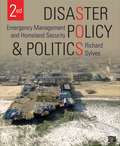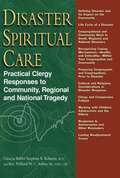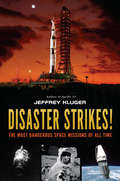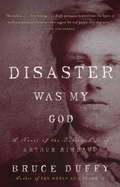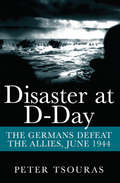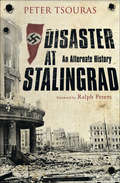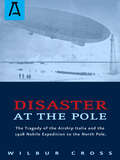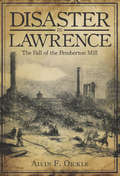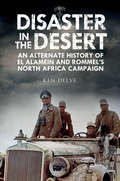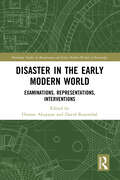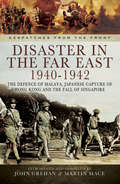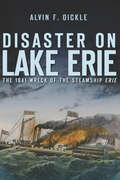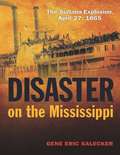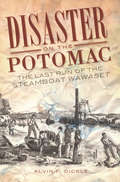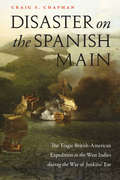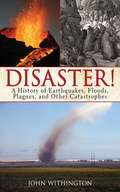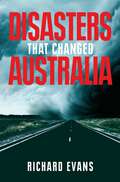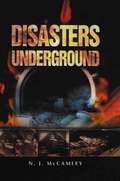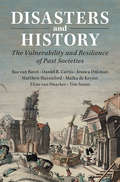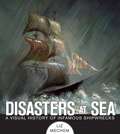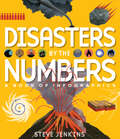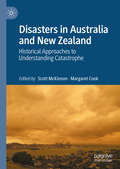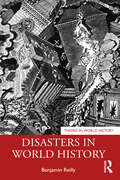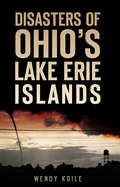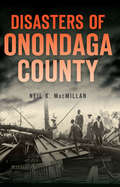- Table View
- List View
Disaster Policy and Politics: Emergency Management and Homeland Security (2nd Edition)
by Richard SylvesDisasters and emergencies challenge people and their governments. Americans routinely want to know how government officials performed during and after events such as the 9/11 terror attacks of 2001; Hurricane Katrina in 2005; the British Petroleum (BP) Deepwater Horizon oil spill in 2010; the Tuscaloosa, Alabama, and Joplin, Missouri tornadoes of 2011
Disaster Spiritual Care: Practical Clergy Responses to Community, Regional and National Tragedy
by Willard W. C. Ashley Stephen B. RobertsThe first comprehensive resource for pastoral care in the face of disaster--a vital resource for clergy, seminarians, pastoral counselors and caregivers of all faith traditions. This essential resource for clergy and caregivers integrates the classic foundations of pastoral care with the unique challenges of disaster response on community, regional and national levels. Offering the latest theological perspectives and tools, along with basic theory and skills from the best disaster response texts, research and concepts, the contributors to this resource are innovators in their fields and represent Christianity, Judaism, Islam and more. Exploring how spiritual care changes following a disaster, and including a comprehensive explanation of a disaster's lifecycle, this is the definitive guidebook for counseling not only the victims of disaster but also the clergy and caregivers who are called to service in the wake of crisis.
Disaster Strikes!: The Most Dangerous Space Missions of All Time
by Jeffrey KlugerTwelve thrilling and terrifying space-mission failures, told by the bestselling author of Apollo 13!There are so many amazing, daring, and exciting missions to outer space that have succeeded. But for every success, there are mistakes, surprises, and flat-out failures that happen along the way. In this collection, bestselling author and award-winning journalist Jeffrey Kluger recounts twelve such disasters, telling the stories of the astronauts and the cosmonauts, the trials and the errors, the missions and the misses.With stories of missions run by both Americans and Russians during the height of the space race, complete with photos of the people and machines behind them, this book delves into the mishaps and the tragedies, small and large, that led humankind to the moon and beyond.Praise for Disaster Strikes!:* "A thrill ride punctuated with spectacular failures--but also spectacular successes." --Kirkus Reviews, starred review* "The [is] text versatile, efficiently functioning as a collection of short reads or a balanced, book-length narrative . . . Always fascinating, at times unsettling, and highly recommended for elementary and middle school collections." --SLJ, starred review"Each compelling episode is crafted as a self-standing adventure, with an opening hook and a satisfying close, making this an excellent source for readalouds for middle-school classes as well as a pleasure for independent readers." --BCCB
Disaster Was My God
by Bruce DuffyThe author of the critically acclaimed novel The World as I Found It brilliantly reimagines the scandalous life of the pioneering, proto-punk poet Arthur Rimbaud. Arthur Rimbaud, the enfant terrible of French letters, more than holds his own with Lord Byron and Oscar Wilde in terms of bold writing and salacious interest. In the space of one year--1871--with a handful of startling poems he transformed himself from a teenaged bumpkin into the literary sensation of Paris. He was taken up, then taken in, by the older and married poet Paul Verlaine in a passionate affair. When Rimbaud sought to end it, Verlaine, in a jealous rage, shot him. Shortly thereafter, Rimbaud--just shy of his twentieth birthday--declared himself finished with literature. His resignation notice was his immortal prose poem A Season in Hell. In time, Rimbaud wound up a prosperous trader and arms dealer in Ethiopia. But a cancerous leg forced him to return to France, to the family farm, with his sister and loving but overbearing mother. He died at thirty-seven. Bruce Duffy takes the bare facts of Rimbaud's fascinating existence and brings them vividly to life in a story rich with people, places, and paradox. In this unprecedented work of fictional biography, Duffy conveys, as few ever have, the inner turmoil of this calculating genius of outrage, whose work and untidy life essentially anticipated and created the twentieth century's culture of rebellion. It helps us see why such protean rock figures as Bob Dylan, Jim Morrison, and Patti Smith adopted Rimbaud as their idol.
Disaster at D-Day: The Germans Defeat the Allies, June 1944 (Military Paperbacks Ser.)
by Peter TsourasThe editor of Hitler Triumphant combines history and fiction to craft an alternative history of the Normandy landings on D-Day. It is June, 1944. The Allied armies are poised for the full-scale invasion of Fortress Europe. Across the Channel, the vaunted Wehrmacht lies waiting for the signs of invasion, ready for the final battle . . . What happens next is well-known to any student of modern history. The outcome could easily have been very different, as Peter Tsouras shows in this masterful and devastating account in which plans, missions, and landings go horribly wrong. Tsouras firmly bases his narrative on facts but introduces minor adjustments at the opening of the campaign—the repositioning of a unit, bad weather and misjudged orders—and examines their effect as they gather momentum and impact on all subsequent events. Without deviating from the genuine possibilities of the situation, he presents a scenario that keeps the reader guessing and changes the course of history.Praise for Disaster at D-Day&“A brilliant and interesting book. The author has pulled off a great feat of imagination and research.&” —Military Illustrated&“This should find a place on the shelves of anyone with an interest in the period and would be invaluable background reading in preparation for a battlefield tour of Normandy.&” —The British Army Review
Disaster at Stalingrad: An Alternate History
by Peter TsourasA fascinating &“what if&” history of one of World War II&’s most iconic battles. It is early September 1942 and the German commander of the Sixth Army, General Paulus, assisted by the Fourth Panzer Army, is poised to advance on the Russian city of Stalingrad. His primary mission was to take the city, crushing this crucial center of communication and manufacturing, and to secure the valuable oil fields in the Caucasus. What happens next is well known to any student of modern history: a brutal war of attrition, characterized by fierce hand-to-hand combat, that lasted for nearly two years, and the eventual victory by a resolute Soviet Red Army. A ravaged German Army was pushed into full retreat. This was the first defeat of Hitler&’s territorial ambitions in Europe and a critical turning point of World War II. But the outcome could have been very different, as Peter Tsouras demonstrates in this fascinating alternate history of this fateful battle. By introducing minor—and realistic— adjustments, Tsouras presents a scenario in which the course of the battle runs quite differently, which in turn throws up disturbing possibilities regarding the outcome of the whole war.
Disaster at the Pole: The Tragedy of the Airship Italia and the 1928 Nobile Expedition to the North Pole
by Wilbur CrossThe true story of the harrowing wreck of the airship Italia during a polar expedition and the heroic rescue attempts to save her and her crew. This is an intriguing and heart-stopping account of the tragic aviation disaster of Commander Umberto Nobile, an Italian aeronautic engineer and airship designer, as he led an expedition to cross the North Pole in the dirigible airship, Italia. Nobile and Norwegian explorer Roald Amundsen had previously led the first successful trip across the North Pole from Europe to America in the airship Norge, beating the attempts by American explorer Admiral Richard Byrd, during history's exciting period known as the Golden Age of Aviation. During an artic storm, the Italia suddenly crashed on an ice pack and the crew was stranded, leading to one of the world's greatest international search and rescue efforts, involving countries such as Russia, Norway, Italy, France and Great Britain.The story is both of the tremendous efforts and heroism of the many search and rescue expeditions, including internationally famous artic explorer Roald Amundsen, who was never seen again, as well as the courage and determination of Nobile and the Italia crew as they battled the elements of the polar ice fields for survival. The event also stirred international politics as Nobile was a well-known opponent to Mussolini's fascist regime and Mussolini is said to have thwarted the successful rescue of Nobile and his crew.In researching this book, author Cross personally went to Italy and interviewed Umberto Nobile as well as nine other survivors from the crash. He also worked with and interviewed the officers at the Norwegian airbase from which the Italia flew on its fatal flight. Additional information came from the Dartmouth University Institute of Artic Studies, including interviews with renowned artic explorer Vilhjalmur Stefansseon, who personally knew General Nobile.
Disaster in Lawrence: The Fall of the Pemberton Mill
by Alvin F. OickleThe destruction was unimaginable. Workers in nearby factories watched with horror as the Pemberton Mill buckled and then collapsed, trapping more than six hundred workers, many of them women and children. Word of the disaster spread quickly and volunteers rushed to the scene. As survivors called out for help, a lantern fell, and within minutes fire engulfed the building, burning those trapped inside. It took days for rescuers to complete the grim task of removing the charred bodies of the dead. Alvin F. Oickle's riveting account illustrates why, nearly a century and a half later, the Pemberton collapse is still considered one of the worst industrial calamities in American history.
Disaster in the Desert: An Alternate History of El Alamein and Rommel's North Africa Campaign
by Ken DelveFor fans of Philip K. Dick and Harry Turtledove, a World War II alternate history novel that imagines a victory for Germany&’s Rommel in North Africa. Summer 1942, and the war in the Middle East is in the balance. Rommel&’s Axis forces are poised on the borders of Egypt and all that is needed is one last push. For that to succeed, Rommel needs supplies and for the Allies to be denied supplies. With Malta still active and disrupting the Axis shipping routes across the Mediterranean he is denied those supplies. Meanwhile, the Allied build-up continues, and Montgomery holds at El Alamein and then counter attacks. Rommel is pushed back and then, in a double blow, the Allies land in Tunisia. The collapse of North Africa leads to the invasion of Italy and contributes to the final Axis defeat. But what if Rommel had won? In this alternate history, Ken Delve proposes that with a few strategic changes by the Axis powers and poor decision by Allied Commanders, the outcome of could have been very different. In this scenario, the Allied invasion in Tunisia fails, Rommel defeats Montgomery and seizes Egypt, leaving the Germans well-placed to sweep up through the Middle East, capturing oil installations and joining up with German forces in Russia.
Disaster in the Early Modern World: Examinations, Representations, Interventions (Routledge Studies in Renaissance and Early Modern Worlds of Knowledge)
by David Rosenthal Ovanes AkopyanHow did early modern societies think about disasters, such as earthquakes or floods? How did they represent disaster, and how did they intervene to mitigate its destructive effects? This collection showcases the breadth of new work on the period ca. 1300-1750. Covering topics that range from new thinking about risk and securitisation to the protection of dikes from shipworm, and with a geography that extends from Europe to Spanish America, the volume places early modern disaster studies squarely at the intersection of intellectual, cultural and socio-economic history. This period witnessed fresh speculation on nature, the diffusion of disaster narratives and imagery and unprecedented attempts to control the physical world. The book will be essential to specialists and students of environmental history and disaster, as well as general readers who seek to discover how pre-industrial societies addressed some of the same foundational issues we grapple with today.
Disaster in the Far East, 1940–1942: Disaster In The Far East 1940- 1942
by Martin Mace John GrehanDespatches in this volume include that on the Far East between October 1940 and December 1941, by Air Chief Marshal Sir Robert Brooke-Popham; the despatch on operations in Hong Kong between 8 and 25 December 1941, by Major-General C.M. Maltby, General Officer Commanding British Troops in China; the report on the air operations during the campaigns in Malaya and Netherland East Indies between December 1941 and March 1942; and the important despatch by Percival detailing the fall of Malaya and Fortress Singapore.This unique collection of original documents will prove to be an invaluable resource for historians, students and all those interested in what was one of the most significant periods in British military history.
Disaster on Lake Erie: The 1841 Wreck of the Steamship Erie
by Alvin F. OickleOn August 9, 1841, the steamship Erie, one of the most elegant and fastest sailing between Buffalo and Chicago, departed carrying 340 passengers. Many were Swiss and German immigrants, planning to start new lives in America's heartland most never made it. The Erie erupted in flames during the night, and despite the heroic efforts of the crew of the Dewitt Clinton, 254 lives were lost. As news of this disaster spread, internationally renowned artists and writers, including Charles Dickens, were inspired to reflect on the lives lost. Historian Alvin F. Oickle's minute-by-minute account weaves together the tragic journey of the passengers, the legend that developed in the aftermath and the fury of a fire on an ocean-like lake.
Disaster on the Mississippi
by Gene Eric SaleckerAt two o’clock in the morning on 27 April 1865, seven miles north of Memphis on the Mississippi, the sidewheel steamboat Sultana’s boilers suddenly exploded. Legally registered to carry 376 people, the boat was packed with 2,100 recently released Union prisoners-of-war. Over 1,700 people died, making it the worst marine disaster in U. S. history. This book looks at the disaster through the eyes of the victims themselves. It offers a concise, minute-by-minute account on the cause of the explosion and its effect on different parts of the boat. To focus on the personal stories of the victims, both civilian and soldier, Gene Eric Salecker patiently collected material from hundreds of letters, period newspaper stories, and other sources. Readers are first introduced to victims while they are languishing in Confederate prisons and follow their release to an exchange camp outside of Vicksburg to their eventual crowding onto the Sultana. His knowledgeable narrative is interwoven with individual reminiscences, including those of the heroic rescuers. He offers unprecedented details about the captain’s handling of the steamboat and corrects some long-held myths about the placement of the soldiers on the Sultana and newspaper coverage of the disaster. A large portion of the book covers rescue attempts, both successful and failed, and the aftermath of the disaster as it affected those involved. With its emphasis on the human-interest aspect of the Sultana, this book brings to the literature a critical point of view and much new research.
Disaster on the Potomac: The Last Run of the Steamboat Wawaset
by Alvin F. OickleFor passengers of the steamboat Wawaset, August 8, 1873, began with a pleasant cruise from Washington, D.C., down the Potomac River. As the Wawaset came into sight of a small Virginia landing, fire broke out below decks, and frantic passengers leapt from the flames only to be pulled down by the swift waters. Author Alvin F. Oickle puts a human face to the tragedy as he profiles some of the seventy-five who perished, among them young mother Alethea Gray and six members of the Reed family. With a fast-paced style and firsthand accounts, Oickle masterfully narrates the last run of the Wawaset against the backdrop of a tense post-Civil War society.
Disaster on the Spanish Main: The Tragic British-American Expedition to the West Indies during the War of Jenkins' Ear
by Craig S. ChapmanDisaster on the Spanish Main unveils and illuminates an overlooked yet remarkable episode of European and American military history and a land-sea venture to seize control of the Spanish West Indies that ended in ghastly failure. Thirty-four years before the Battles of Lexington and Concord, a significant force of American soldiers deployed overseas for the first time in history. Colonial volunteers, 4,000 strong, joined 9,000 British soldiers and 15,000 British sailors in a bold amphibious campaign against the key port of Cartagena de Indias. From its first chapter, Disaster on the Spanish Main reveals a virtually unknown adventure, engrosses with the escalating conflict, and leaves the reader with an appreciation for the struggles and sacrifices of the 13,000 soldiers, sailors, and marines who died trying to conquer part of Spain&’s New World empire.Disaster on the Spanish Main breaks new ground on the West Indies expedition in style, scope, and perspective and uncovers the largely untold American side of the story.
Disaster!: A History of Earthquakes, Floods, Plagues, and Other Catastrophes
by John WithingtonTune into the news today, and one would think that human beings were at risk of being wiped from the face of the earth-by tsunamis, earthquakes, swine flu, or terrorism. One could be forgiven for thinking that we are in far more danger today than ever before. The fact of the matter is that danger has always stalked mankind. From ancient volcanoes and floods to the cholera and small pox, to Hitler and Stalin's genocidal murders during the twentieth century, our continued existence has always seemed perilous. Now, out of our horror comes an entertaining and epic journal through the history of disaster. Disaster! offers perspective on today's fears by revealing how dangerous our world has always been. Natural disasters and man-made catastrophes mark every era. Here is the Black Death that killed seventy-five million in Europe and Asia during the 1300s; the 1883 volcanic eruption on Krakatoa; the Irish potato famine of the mid-nineteenth century; the Nazi Holocaust; the 1970 storm in Bangladesh, now considered the deadliest in history; and more. Train crashes, air disasters, and shipwrecks litter human history. Sure to scare, inform, and entertain, Disaster! is a book of serious history that is as much fun as any horror film.
Disasters That Changed Australia
by Richard EvansAustralian history is full of disasters. Some are natural but many more are man-made, results of individual or collective stupidity, reckless decisions, or greed. In Disasters that Changed Australia, Richard Evans nominates the worst disasters in an engrossing, insightful account of what happened and why. Picture British General, Douglas Haig through sheer arrogance and determination sending thousands of Australian men into swampy, disease-ridden enemy territory for no strategic gain. Or a feral legion of rabbits let loose on the environment, turning furry friends into an uncontrollable plague. Including Cyclone Tracy, Black Friday, the Snowy Mountains Scheme and the destruction of megafauna thousands of years ago, these are just many of debacles that have defined Australia. Richard Evans goes beneath the familiar stories and myths, and urges us to rethink how we respond to disasters to avoid making the same mistakes again.
Disasters Underground
by N. J. McCamleyThe rapid expansion of the RAF during the mid/late 1930s necessitated a massive storage requirement for high explosive bombs and other ordinance. Drawing on the experience of the Great War ammunition factories, the authorities set about identifying underground sites around Britain safe from the threat of air attack. Unfortunately in the haste of the moment safety arrangements were not a high priority and, as a result, there were a number of appalling accidents; the most serious occurred in November 1944 when 3,800 tons of HE bombs detonated at the same time resulting in the deaths of 68 people in a Staffordshire quarry.
Disasters and History: The Vulnerability and Resilience of Past Societies
by Tim Soens Daniel R. Curtis Jessica Dijkman Bas van Bavel Matthew Hannaford Maïka de Keyzer Eline van OnackerDisasters and History offers the first comprehensive historical overview of hazards and disasters. Drawing on a range of case studies, including the Black Death, the Lisbon earthquake of 1755 and the Fukushima disaster, the authors examine how societies dealt with shocks and hazards and their potentially disastrous outcomes. They reveal the ways in which the consequences and outcomes of these disasters varied widely not only between societies but also within the same societies according to social groups, ethnicity and gender. They also demonstrate how studying past disasters, including earthquakes, droughts, floods and epidemics, can provide a lens through which to understand the social, economic and political functioning of past societies and reveal features of a society which may otherwise remain hidden from view. This title is also available as Open Access on Cambridge Core.
Disasters at Sea: A Visual History of Infamous Shipwrecks
by Liz MechemA fully illustrated collection of the most thrilling shipwrecks of all time!Experience the mystery and wonder of the bottom of the sea with over sixty accounts of shipwreck catastrophes. Illustrated with detailed maps and shipwreck locations, Disasters at Sea takes readers on a fascinating journey through history and to the ocean floor. Learn all about the historical details and theories of the most infamous shipwrecks--from the most well-known sinkings like the Titanic, to the obscure, mysterious drifting ghost ships and unexplained disappearances. Subjects include:* Tragedies by Mother Nature* Shipwrecks and war* Fatal errors* Legends, myths, mysteries* And many more!Whether by human error, collision, piracy, or mutiny, this book has them all. With shipwrecks from the Old Testament, to ancient Greece, to modern times, this exciting book is compellingly written with accompanying sources, high-quality images, and a great deal of evidence. Find out interesting tidbits about Christopher Columbus's Santa Maria, which eluded discovery for centuries despite long-term investigations. Stay afloat with the Mary Celeste and the Carroll A. Deering--ships that did not wreck at all but whose entire crews disappeared, never to be found. Readers are no doubt familiar with the tragedy of the Titanic, but this book also recounts the Wilhelm Gustloff, which took nine thousand lives at the end of World War II.Disasters at Sea is sure to offer an addicting and thrilling voyage that will leave you reading over and over again. This is an exciting book for the history buff--or for anyone looking for a fascinating read!
Disasters by the Numbers: A Book of Infographics
by Steve JenkinsAn amazing look at Earth&’s natural disasters as seen through numbers, facts, and stunning infographics from Caldecott Honor–winning author-illustrator Steve Jenkins! From Caldecott Honor–winning author-illustrator Steve Jenkins comes an in-depth look at the world's natural disasters, broken down into four distinct categories: earth, weather, life, and space. From timelines of causes and outcomes of each disaster, graphs highlighting humans' effect on the earth, and a text teeming with fresh, unexpected, and accurate information ready for readers to easily devour, Disasters by the Numbers is unmatched and sure to wow fans old and new.
Disasters in Australia and New Zealand: Historical Approaches to Understanding Catastrophe
by Scott McKinnon Margaret CookDisasters in Australia and New Zealand brings together a collection of essays on the history of disasters in both countries. Leading experts provide a timely interrogation of long-held assumptions about the impacts of bushfires, floods, cyclones and earthquakes, exploring the blurred line between nature and culture, asking what are the anthropogenic causes of ‘natural’ disasters? How have disasters been remembered or forgotten? And how have societies over generations responded to or understood disaster? As climate change escalates disaster risk in Australia, New Zealand and around the world, these questions have assumed greater urgency. This unique collection poses a challenge to learn from past experiences and to implement behavioural and policy change. Rich in oral history and archival research, Disasters in Australia and New Zealand offers practical and illuminating insights that will appeal to historians and disaster scholars across multiple disciplines.
Disasters in World History (Themes in World History)
by Benjamin ReillyDisasters in World History surveys the development of disaster studies as a discipline as well as presenting historical case studies and theories used by historians to understand disasters. Disasters, here defined as the complex interaction between natural hazards and specific human vulnerabilities, have frequently left a mark on human history. Cataclysms have toppled dynasties, fueled massacres, and shaped the culture of societies frequently affected by natural hazards. This volume fosters understanding of such events by considering both social science theory and the natural science concepts relevant to disaster studies. In addition, the text makes heavy use of an emerging psychological theory relevant to disaster studies: the behavioral immune system, which helps to explain why xenophobic behavior and even violence often erupt in the aftermath of disasters. Chapters consider specific examples of disasters: earthquakes, tsunamis, volcanic eruptions, climate change (including modern anthropogenic climate change or global warming), and tropical cyclones.This book is an accessible resource, ideal for undergraduates and instructors in world history, environmental history, and disaster studies courses.
Disasters of Ohio’s Lake Erie Islands (Disaster)
by Wendy KoileBeautiful and deadly, the Lake Erie islands off the coast of Ohio have seen their fair share of disasters. The Victory Hotel on South Bass Island at Put-in-Bay was once the largest hotel in the nation. But the grand residence was reduced to ashes after a spark quickly became a raging, uncontrollable inferno. Reports of smallpox on Pelee Island resulted in mass hysteria and the quarantine of an entire island. At the Toledo Harbor Lighthouse, one light keeper was frozen in for days with his deceased colleague until he could make a desperate escape. Wendy Koile chronicles the fiercest calamities to shatter the tranquility of these solitary shores.
Disasters of Onondaga County (Disaster)
by Neil K. MacmillanThe city of Syracuse and Onondaga County have a long and storied history of natural and man-made calamity. Although often considered a moderate weather region, Mother Nature has not spared it from destruction. A tornado devastated picturesque Longbranch Park in 1912, and the rare Hurricane Hazel reached Onondaga’s borders in 1954. A fire ravaged Syracuse’s famed Bastable Block building in 1923. During a children’s concert and festival, the floor of the Central Baptist Church collapsed, tragically claiming scores of lives and injuring more than one hundred. Author and historian Neil MacMillan charts the history of Onondaga County catastrophes.
